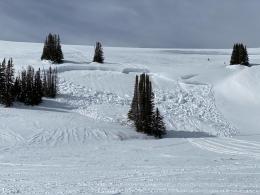Good Morning. This is Dave Zinn with the Gallatin National Forest Avalanche Forecast on Tuesday, March 9th at 7:15 a.m. Today’s forecast is sponsored by Blitz Motorsports and Yamaha and Community Food Co-op. This forecast does not apply to operating ski areas.
Snow returned yesterday with 6” new near West Yellowstone and 2-4” near Bozeman, Big Sky, and Cooke City. Precipitation likely began as rain south of Big Sky. Winds are 10-20 mph from the southwest to northwest, and temperatures are in the teens to low-20s F. The mountains will get a trace to 1” more snow this morning with a bit more near Cooke City. Winds will be 10-20 mph from the southwest to northwest and temperatures will be in the 20s to low-30s F.
The mountains south of Big Sky through West Yellowstone picked up 4-6” of fresh snow equal to 0.4-0.5” of snow water equivalent-SWE with 2-3” (0.2” SWE) in the Bridger Range through Big Sky. The depth will be greater in areas of drifted snow. As I explain in my video from the Throne, the snowpack structure remains poor, but without significant snowfall, avalanches breaking on deeply buried weak layers are unlikely. The last human-triggered slab avalanches we know of occurred in the Madison Range nine days ago (avalanche/weather log). On Sunday, Alex and I went into the Maid of the Mist Basin to look at one of these old, deep-slab avalanches (video, photo). A skier or rider getting unlucky and hitting the trigger-point of one of these giant slides is a sobering thought.
Yesterday, skiers north of West Yellowstone dug two snowpits, got unstable results, and subsequently decided to stay in low-angle terrain. In Hyalite, a group ascending a steep chute noticed the snow depth change dramatically from their first pit, got unstable results in a second, and decided to pull the plug. These examples demonstrate how we should use snowpack assessment tools to find isolated areas of instability and adjust plans accordingly.
Today, human-triggered avalanches are possible in wind-loaded terrain. These slides will most likely be small, but be wary of the chance that a small slide or cornice collapse could trigger a larger avalanche. The avalanche danger is MODERATE on wind-loaded terrain and LOW on non-wind-loaded terrain.
The mountains around Cooke City received 3” of new snow equal to 0.3” of SWE. The snowpack lacks widespread buried weak layers and large slab avalanches are unlikely. Yesterday, riders east of Cooke City triggered a small, wind-loaded slope after cutting across it a couple of times (photos and details) and skiers west of Cooke City saw a large cornice collapse on a small slope (photo). These are good examples of how riders and skiers may still find isolated instability on low danger days and why safe travel protocols are vital on all days spent in avalanche terrain. Everyone should carry and be familiar with avalanche rescue gear and expose only one person at a time to avalanche hazards. Today, manage small slabs and loose snow avalanches by avoiding terrain that may elevate a slide’s consequences. The danger is LOW in the mountains near Cooke City.
If you get out, please send us your observations no matter how brief. You can submit them via our website, email (mtavalanche@gmail.com), phone (406-587-6984), or Instagram (#gnfacobs).
The Beacon Park at Beall Park in Bozeman is running!
The Friends of the Avalanche Center in partnership with the City of Bozeman put in a Beacon Park at Beall Park. It is located on the north side of the Beall building between N. Bozeman Ave. and the ice rink. Stop by with your avalanche transceiver and do a few practice rescue drills. Your partner will thank you.
Upcoming Avalanche Education and Events
See our education calendar for an up-to-date list of all local classes. Here are a few select upcoming events and opportunities to check out:
March 20, 5:30 p.m., Snowpack Update for Bozeman Splitfest, online Link to Join HERE
March 24, 6 p.m., Free 1-Hour Avalanche Awareness, online Link to Join HERE
March 29, 6 p.m., Free 1-Hour Avalanche Awareness, online Link to Join HERE
Accident reports have now been posted for many of February’s tragic avalanche fatalities across the western US. Take a bit of time to read them and try to find lessons to help yourself become a safer backcountry traveller.



